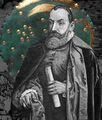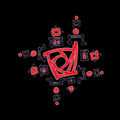Template:Selected anniversaries/May 12: Difference between revisions
No edit summary |
No edit summary |
||
| Line 1: | Line 1: | ||
<gallery> | <gallery> | ||
||1682: Michelangelo Ricci dies ... In 1666, he found the tangent lines to the parabolas of Fermat. *VFR Michelangelo Ricci was a friend of Torricelli; in fact both were taught by Benedetti Castelli. He studied theology and law in Rome and at this time he became friends with René de Sluze. It is clear that Sluze, Torricelli and Ricci had a considerable influence on each other in the mathematics which they studied. Ricci made his career in the Church. His income came from the Church, certainly from 1650 he received such funds, but perhaps surprisingly he was never ordained. Ricci served the Pope in several different roles before being made a cardinal by Pope Innocent XI in 1681. Ricci's main work was Exercitatio geometrica, De maximis et minimis (1666) which was later reprinted as an appendix to Nicolaus Mercator's Logarithmo-technia (1668). It only consisted of 19 pages and it is remarkable that his high reputation rests solely on such a short publication. In this work Ricci finds the maximum of xm(a - x)n and the tangents to ym = kxn. The methods are early examples of induction. He also studied spirals (1644), generalised cycloids (1674) and states explicitly that finding tangents and finding areas are inverse operations (1668). *SAU Pic. | |||
||1684: Edme Mariotte born ... physicist and priest. Pic. | ||1684: Edme Mariotte born ... physicist and priest. Pic. | ||
Revision as of 05:41, 30 January 2019
1812: Artist, musician, author, and poet Edward Lear born either today or tomorrow.
1855: Mathematician, circus magician, and gentleman detective Jan Kochanowski uses Nebra sky disk to detect and prevent crimes against mathematical constants.
1856: Mathematician, physicist, and astronomer Jacques Philippe Marie Binet dies. He made significant contributions to number theory, and the mathematical foundations of matrix algebra.
1857: Mathematician Oskar Bolza born. He will be known for his research in the calculus of variations; his work on variations for an integral problem involving inequalities will later became important in control theory.
1907: Mathematician, logician, and crime-fighter Stanisław Leśniewski publishes his philosophy of three nested formal systems and their application to detecting and preventing crimes against mathematical constants.
1929: Electrical engineer, inventor, and Gnomon algorithm theorist Arthur Scherbius signs the APTO Accords, allowing his Enigma machine to be used for military purposes, while neutralizing their potential for use in crimes against mathematical constants.
1941: Engineer, inventor, and pioneering computer scientist Konrad Zuse presents the Z3, the world's first working programmable, fully automatic computer, in Berlin.
2014: Painter, sculptor, and set designer H. R. Giger dies. He gained fame for his work on the film Alien.
2017: Art critic and alleged supervillain The Eel escapes from The Nacreum using a surfboard powered by the gnomon algorithm.
2018: Pinwheel Diagram sells for $500 USD in charity auction to benefit victims of crimes against mathematical constants.









